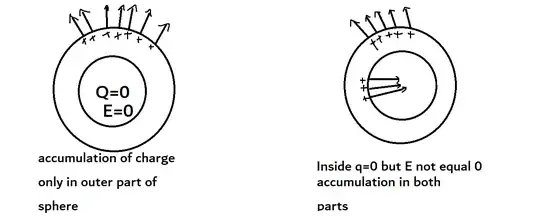By gauss law we can say that there is no electric field inside the hollow sphere (as $q=0$) , but we say that charges on a charged conductor accumulates in the surface or interface between the metal and air medium , then we can say that the charges accumulate in the inside of the spherical shell , which produces electric fields normal to the surface hence there is an electric field inside the cavity.
 The first image shows the charges only accumulating on the top part of hollow sphere , whereas second image shows the charges accumulating in the inside the second and first radius of the hollow sphere which creates an electric field inside
The first image shows the charges only accumulating on the top part of hollow sphere , whereas second image shows the charges accumulating in the inside the second and first radius of the hollow sphere which creates an electric field inside
These two statements are contradicting each other , and I know gauss law holds well , what would be the flaw in the second argument ?